Enhancing Precision Agriculture Efficiency Through Edge Computing-Enabled Wireless Sensor Networks: A Data Aggregation Perspective †
Abstract
1. Introduction
- We developed a framework for edge computing-enabled WSNs considering QoD and DCT constraints.
- We proposed an edge computing-enabled technique for collecting valid data based on parameters such as node position and data type, ensuring high QoD with real-time execution.
- We introduced a dual-level data aggregation approach, utilizing CHs and GNs to minimize data redundancy and reduce transmission frequency. This approach optimizes energy efficiency and extends network lifetime by consolidating data into a single long-range transmission from the GN to BS.
2. Proposed Edge Computing-Enabled WSN Framework
| Algorithm 1: Edge Computing-Enabled Data Aggregation |
|
2.1. Working Procedure of Proposed Framework
2.1.1. Cluster Formation and CH Selection
2.1.2. Data Aggregation and Transmission
3. Performance Evaluation
3.1. Simulation Parameters
3.2. Radio Energy Dissipation Model
4. Results and Discussion
4.1. Comparison with LEACH
4.2. Comparison with Sensing Algorithms
5. Conclusions
Author Contributions
Funding
Institutional Review Board Statement
Informed Consent Statement
Data Availability Statement
Conflicts of Interest
References
- Akhtar, M.N.; Shaikh, A.J.; Khan, A.; Awais, H.; Bakar, E.A.; Othman, A.R. Smart Sensing with Edge Computing in Precision Agriculture for Soil Assessment and Heavy Metal Monitoring: A Review. Agriculture 2021, 11, 475. [Google Scholar] [CrossRef]
- D’Agostino, D.; Morganti, L.; Corni, E.; Cesini, D.; Merelli, I. Combining Edge and Cloud Computing for Low-Power, Cost-Effective Metagenomics Analysis. Futur. Gener. Comput. Syst. 2019, 90, 79–85. [Google Scholar] [CrossRef]
- Alam, N. Opportunity Assessment and Feasibility Study of IoT-Based Smart Farming in Bangladesh for Meeting Sustainable Development Goals. In The Fourth Industrial Revolution and Beyond; Springer: Cham, Switzerland, 2023; pp. 723–736. [Google Scholar]
- Anees, T.; Habib, Q.; Al-Shamayleh, A.S.; Khalil, W.; Obaidat, M.A.; Akhunzada, A. The Integration of WoT and Edge Computing: Issues and Challenges. Sustainability 2023, 15, 5983. [Google Scholar] [CrossRef]
- Hoque, M.J.; Ahmed, M.R.; Hannan, S. An Automated Greenhouse Monitoring and Controlling System Using Sensors and Solar Power. Eur. J. Eng. Res. Sci. 2020, 5, 510–515. [Google Scholar] [CrossRef]
- Chataut, R.; Phoummalayvane, A.; Akl, R. Unleashing the Power of IoT: A Comprehensive Review of IoT Applications and Future Prospects in Healthcare, Agriculture, Smart Homes, Smart Cities, and Industry 4.0. Sensors 2023, 23, 7194. [Google Scholar] [CrossRef] [PubMed]
- Bakthavatchalam, K. IoT Framework for Measurement and Precision Agriculture: Predicting the Crop Using Machine Learning Algorithms. Technologies 2022, 10, 13. [Google Scholar] [CrossRef]
- Jiang, C.; Fan, T.; Gao, H.; Shi, W.; Liu, L.; Cerin, C.; Wan, J. Energy-Aware Edge Computing: A Survey. Comput. Commun. 2020, 151, 556–580. [Google Scholar] [CrossRef]
- Hoque, M.J.; Islam, M.S.; Khaliluzzaman, M. Incorporating Meteorological Data and Pesticide Information to Forecast Crop Yields Using Machine Learning. IEEE Access 2024, 12, 47768–47786. [Google Scholar] [CrossRef]
- Guillén, M.A.; Llanes, A.; Imbernón, B.; Martínez-España, R.; Bueno-Crespo, A.; Cano, J.C.; Cecilia, J.M. Performance Evaluation of Edge-Computing Platforms for the Prediction of Low Temperatures in Agriculture Using Deep Learning. J. Supercomput. 2021, 77, 818–840. [Google Scholar] [CrossRef]
- Hoque, M.J.; Islam, M.S.; Khaliluzzaman, M. A Fuzzy Logic- and Internet of Things-Based Smart Irrigation System. Eng. Proc. 2023, 58, 93. [Google Scholar] [CrossRef]
- Mowla, M.N.; Mowla, N.; Shah, A.F.M.S.; Rabie, K.M.; Shongwe, T. Internet of Things and Wireless Sensor Networks for Smart Agriculture Applications: A Survey. IEEE Access 2023, 11, 145813–145852. [Google Scholar] [CrossRef]
- Veerachamya, R.; Ramar, R.; Balaji, S.; Sharmila, L. Autonomous Application Controls on Smart Irrigation. Comput. Electr. Eng. 2022, 100, 230–245. [Google Scholar] [CrossRef]
- Bhola, A.; Srivastava, S.; Noonia, A.; Sharma, B.; Narang, S.K. A Status Quo of Machine Learning Algorithms in Smart Agricultural Systems Employing IoT-Based WSN: Trends, Challenges, and Futuristic Competences. In Machine Intelligence, Big Data Analytics and IoT in Image Processing: Practical Applications; Wiley: Hoboken, NJ, USA, 2023; pp. 177–195. [Google Scholar]
- Kim, J.; Kim, C.; Son, B.; Ryu, J.; Kim, S. A Study on Time-Series DBMS Application for EdgeX-Based Lightweight Edge Gateway. In Proceedings of the 2020 International Conference on Information and Communication Technology Convergence (ICTC), Jeju, Republic of Korea, 21–23 October 2020; pp. 1795–1798. [Google Scholar]
- Abdollahi, A.; Rejeb, K.; Rejeb, A.; Mostafa, M.M.; Zailani, S. Wireless Sensor Networks in Agriculture: Insights from Bibliometric Analysis. Sustainability 2021, 13, 12011. [Google Scholar] [CrossRef]
- Ahmed, Z.U.; Mortuza, M.G.; Uddin, M.J.; Kabir, M.H.; Mahiuddin, M.J.; Hoque, M.J. Internet of Things Based Patient Health Monitoring System Using Wearable Biomedical Device. In Proceedings of the 2018 International Conference on Innovation in Engineering and Technology (ICIET), Dhaka, Bangladesh, 27–28 December 2018; pp. 1–5. [Google Scholar] [CrossRef]
- Saranya, T.; Deisy, C.; Sridevi, S.; Anbananthen, K.S.M. A Comparative Study of Deep Learning and Internet of Things for Precision Agriculture. Eng. Appl. Artif. Intell. 2023, 122, 106028. [Google Scholar] [CrossRef]
- Dhal, S.; Wyatt, B.M.; Mahanta, S.; Bhattarai, N.; Sharma, S.; Rout, T.; Saud, P.; Acharya, B.S. Internet of Things (IoT) in Digital Agriculture: An Overview. Agronomy 2023, 13, 20. [Google Scholar] [CrossRef]
- Hoque, M.J.; Ahmed, M.R.; Uddin, M.J.; Faisal, M.M.A. Automation of Traditional Exam Invigilation Using CCTV and Biometric. Int. J. Adv. Comput. Sci. Appl. 2020, 11, 65. [Google Scholar] [CrossRef]
- Avşar, E.; Mowla, M.N. Wireless Communication Protocols in Smart Agriculture: A Review on Applications, Challenges, and Future Trends. Ad Hoc Netw. 2022, 136, 102130. [Google Scholar] [CrossRef]
- Karunathilake, E.M.B.M.; Le, A.T.; Heo, S.; Chung, Y.S.; Mansoor, S. The Path to Smart Farming: Innovations and Opportunities in Precision Agriculture. Agriculture 2023, 13, 1593. [Google Scholar] [CrossRef]
- Dhruva, A.D.; Prasad, B.; Kamepalli, S.; Sakthy, S.S.; Kunisetti, S. An Efficient Mechanism Using IoT and Wireless Communication for Smart Farming. Mater. Today Proc. 2023, 80, 3691–3696. [Google Scholar] [CrossRef]
- Heinzelman, W.R.; Chandrakasan, A.; Balakrishnan, H. Energy-Efficient Communication Protocol for Wireless Microsensor Networks. In Proceedings of the 33rd Annual Hawaii International Conference on System Sciences, Maui, HI, USA, 4–7 January 2000; Volume 2, p. 10. [Google Scholar] [CrossRef]
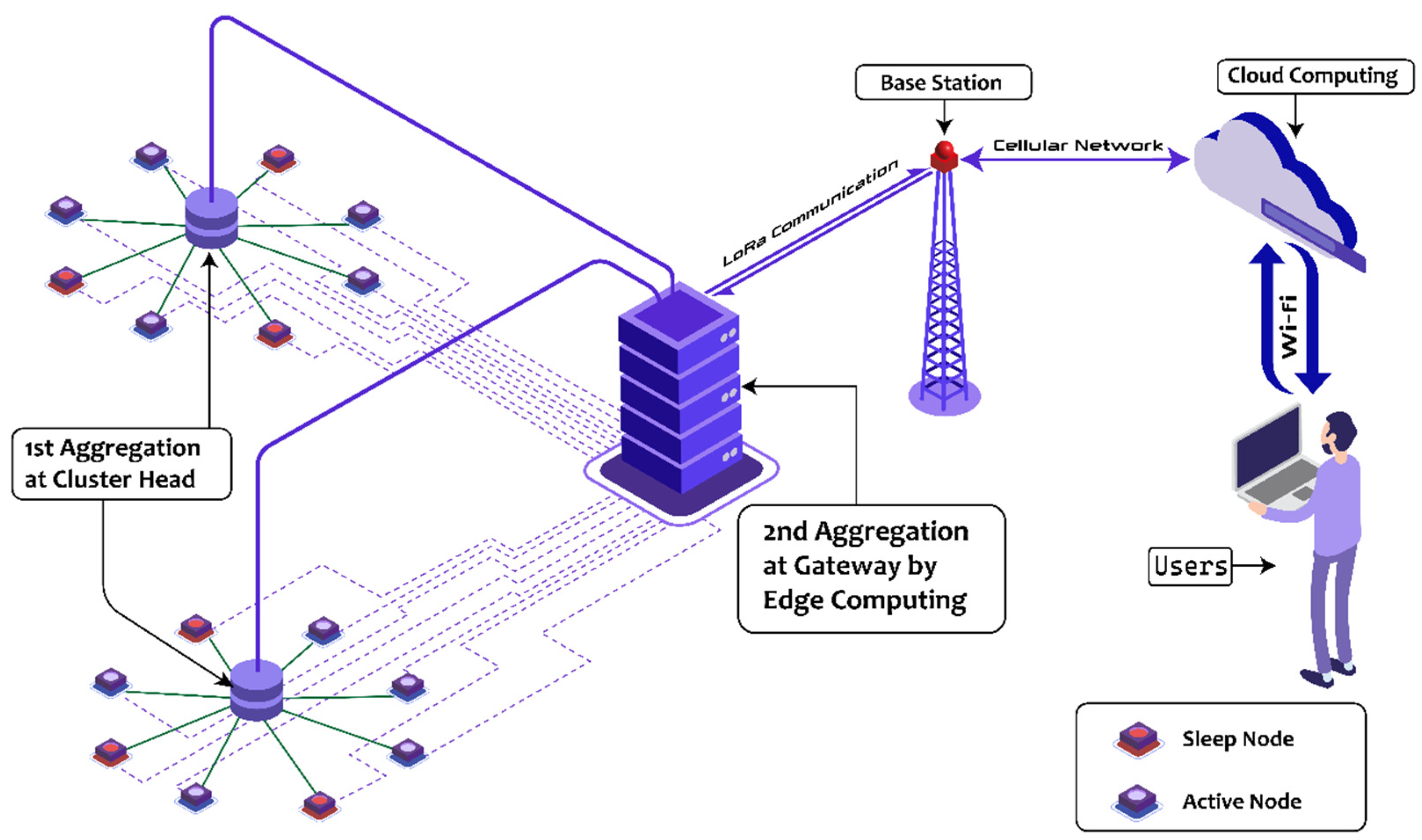
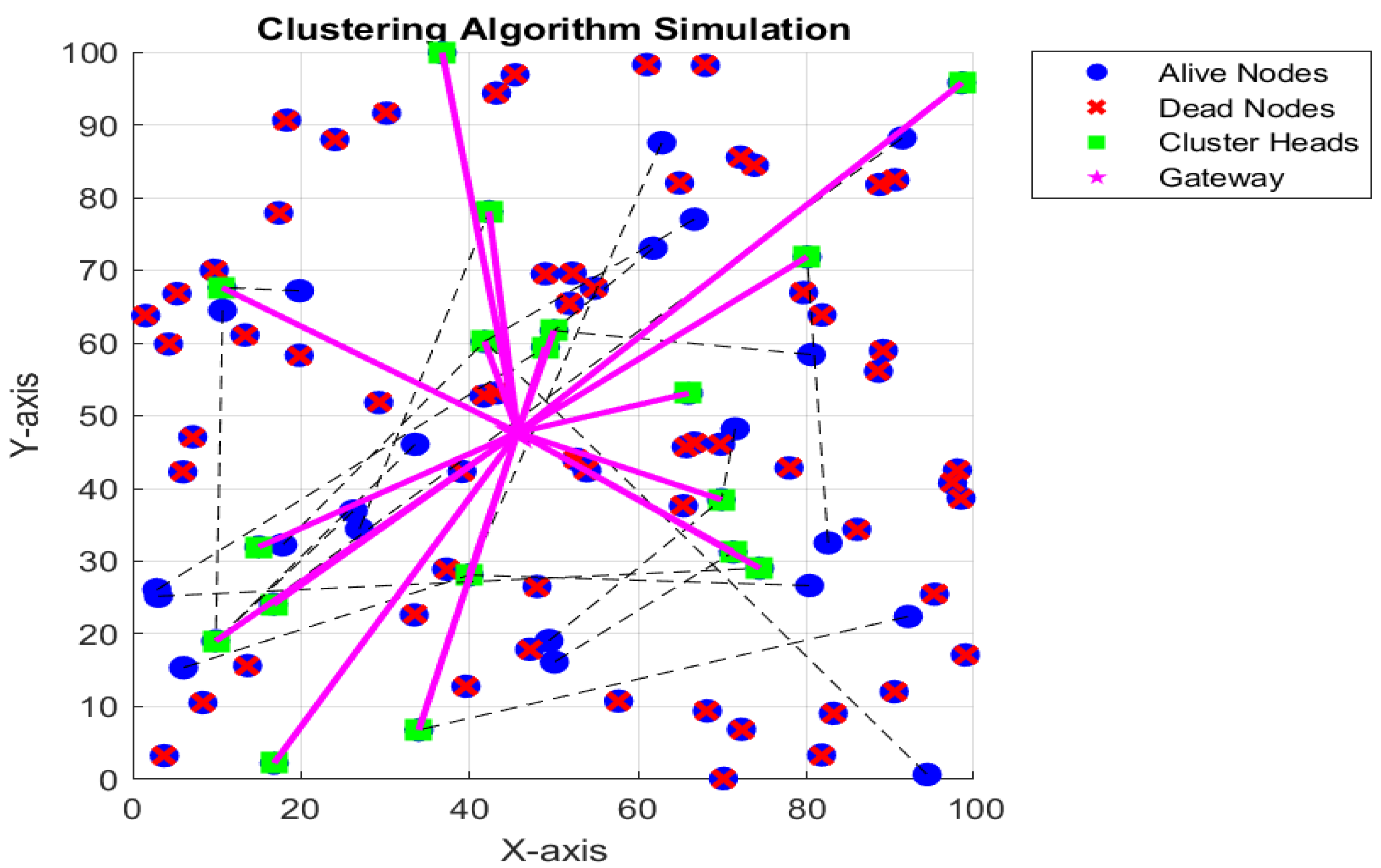
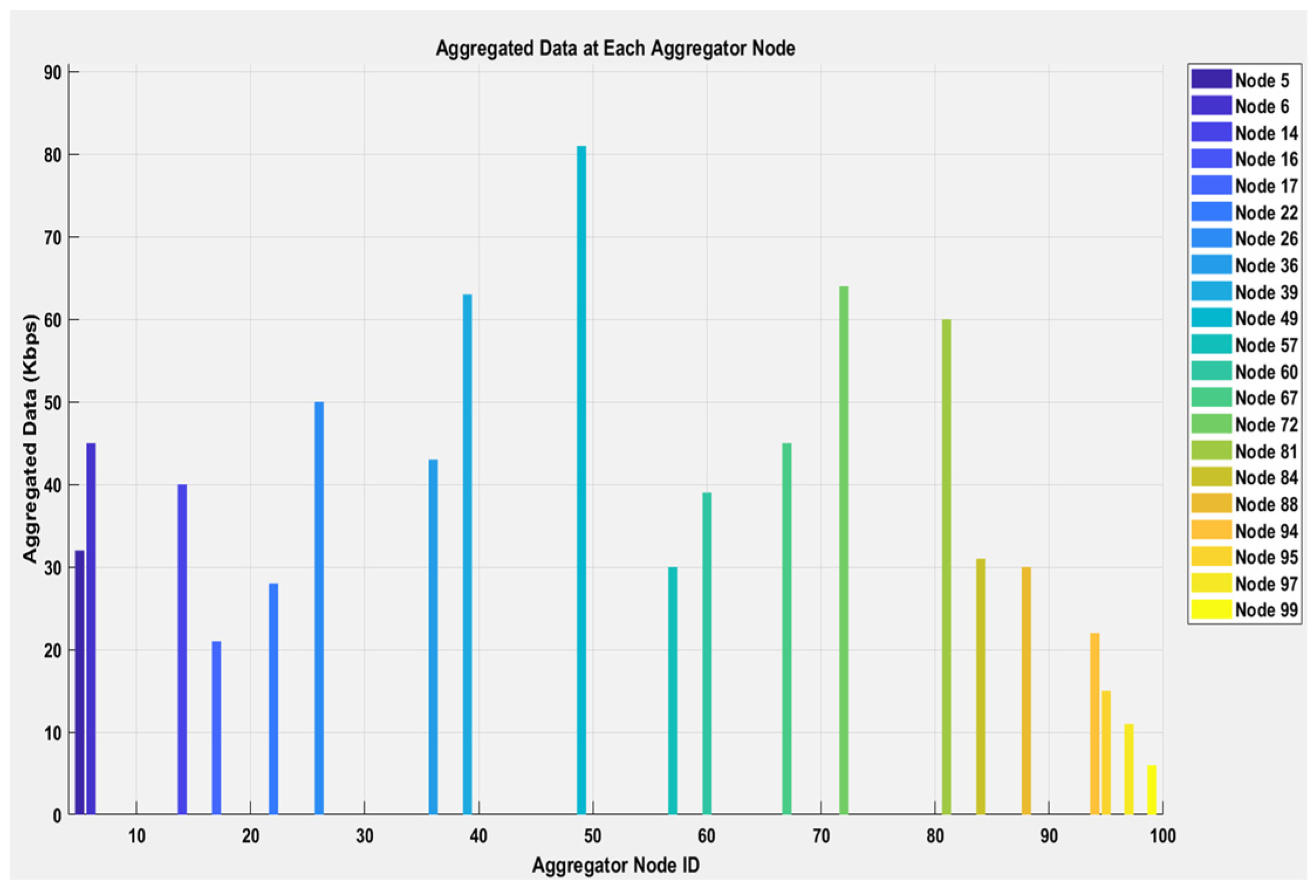

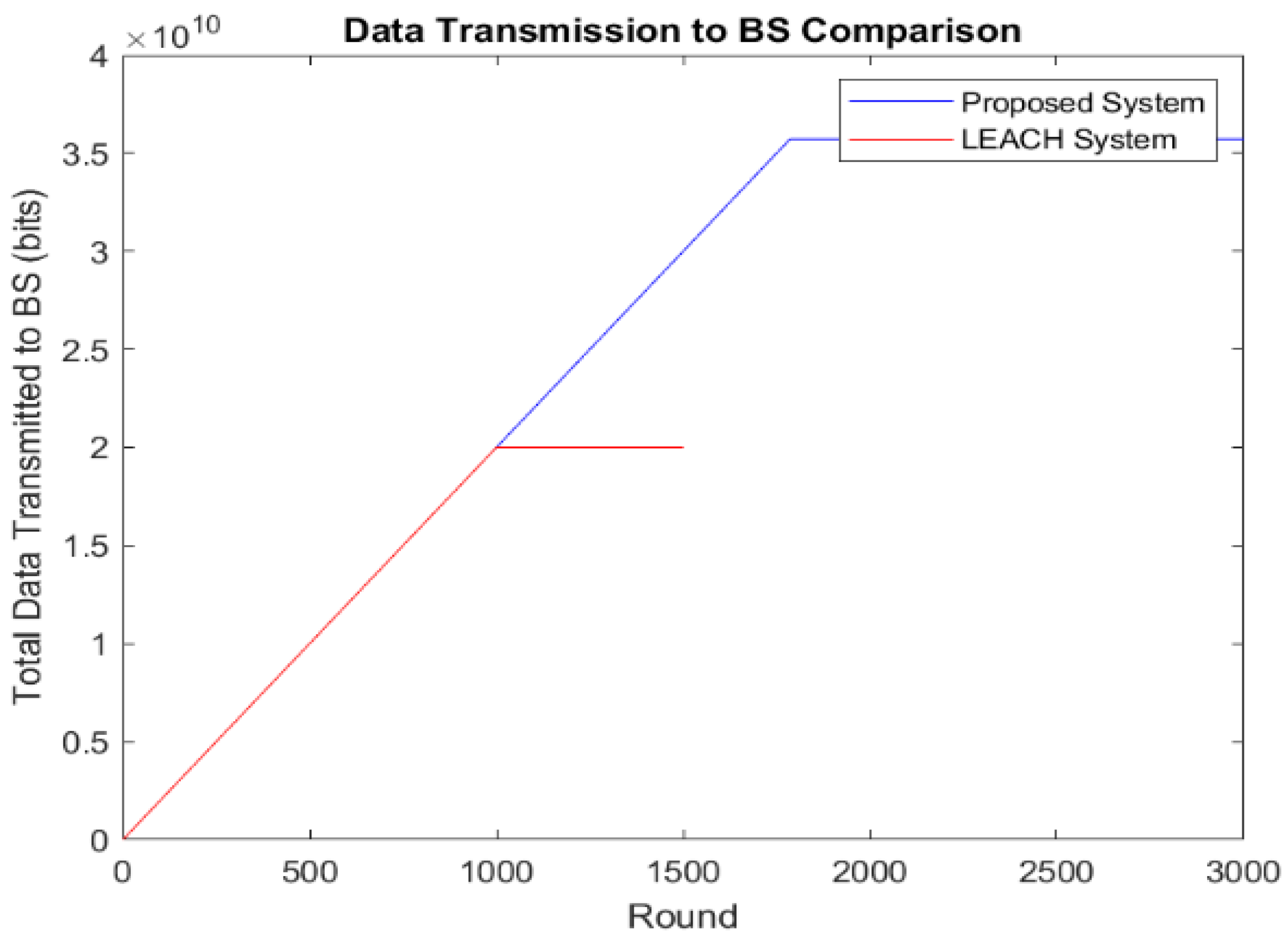
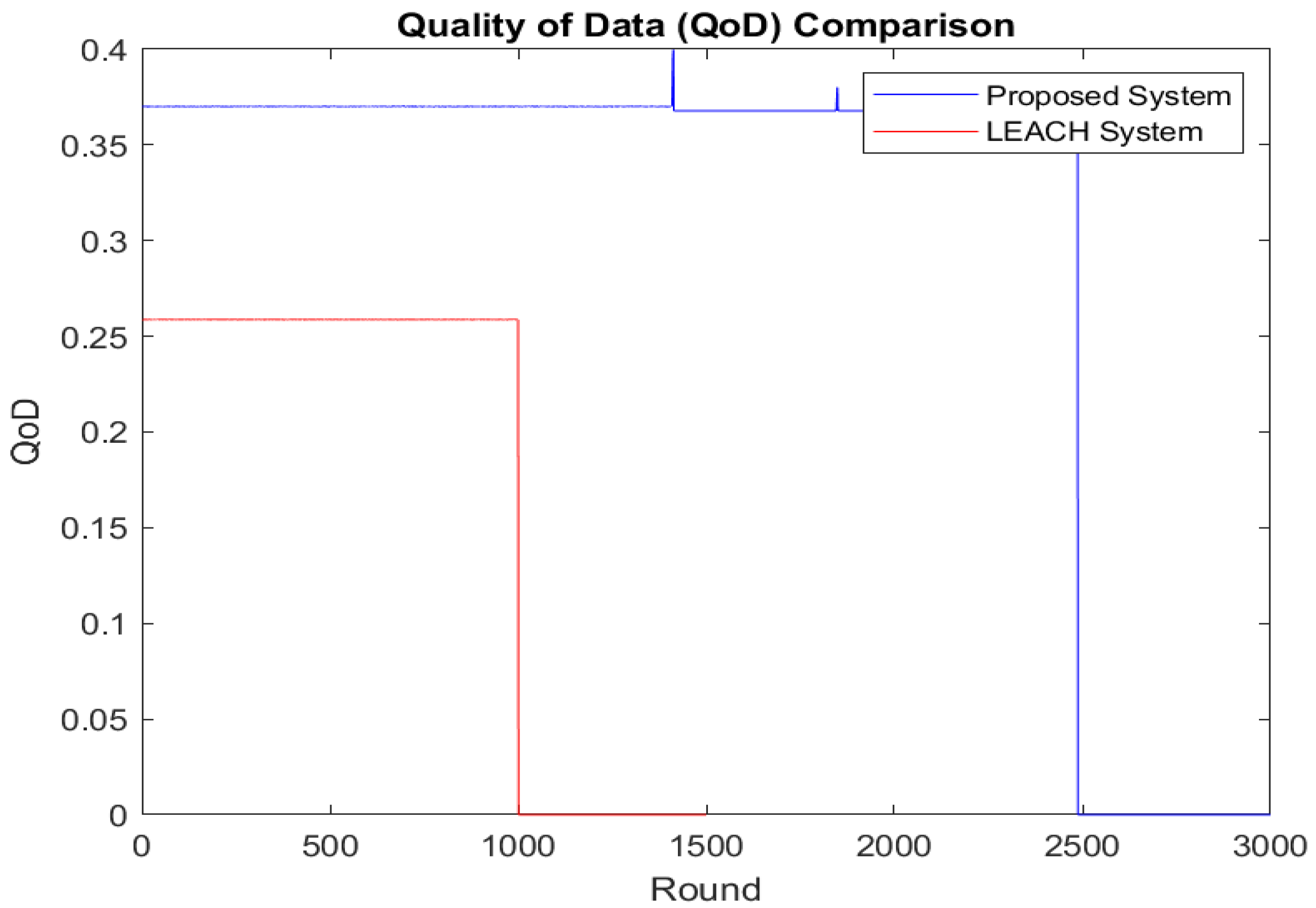

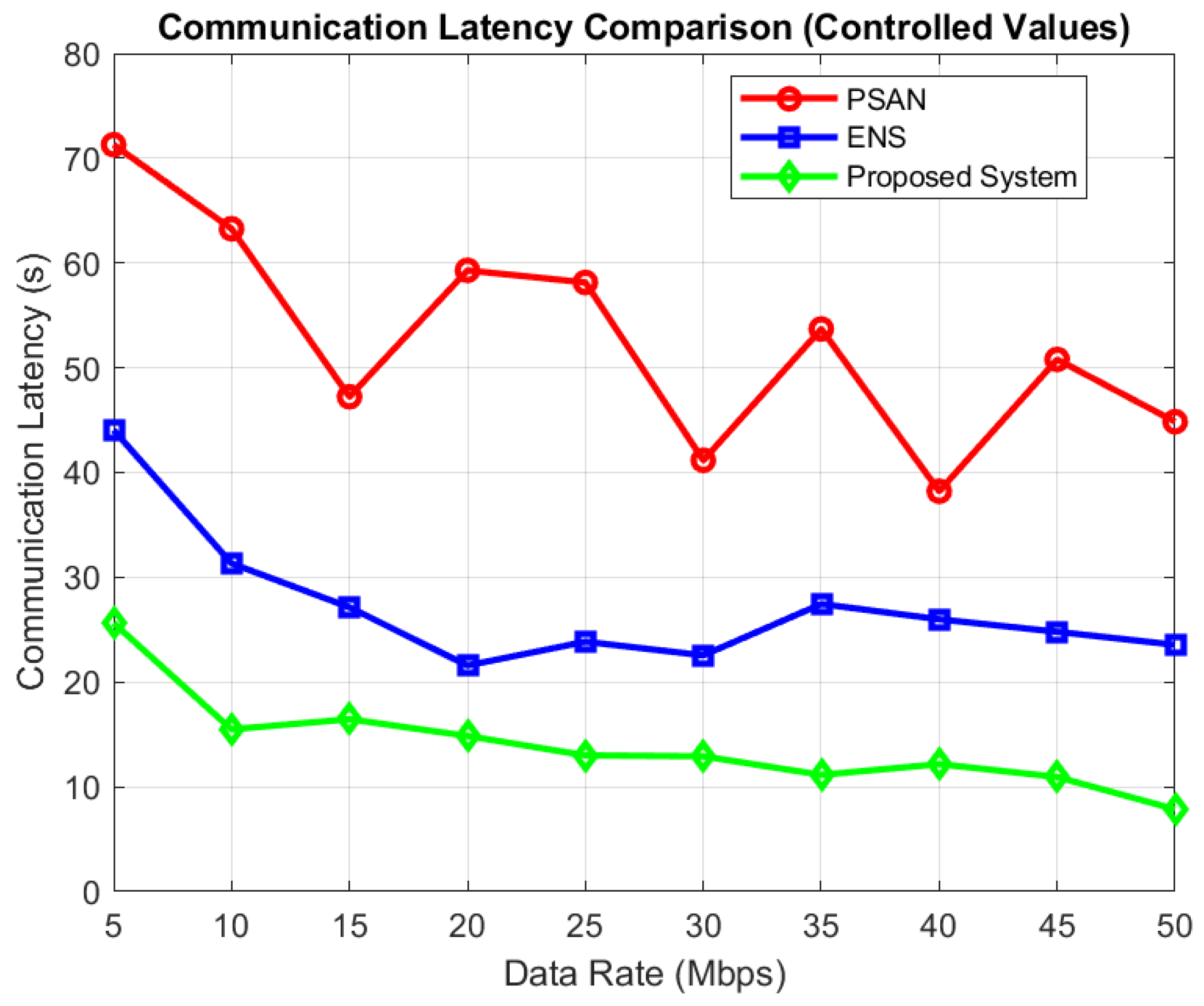
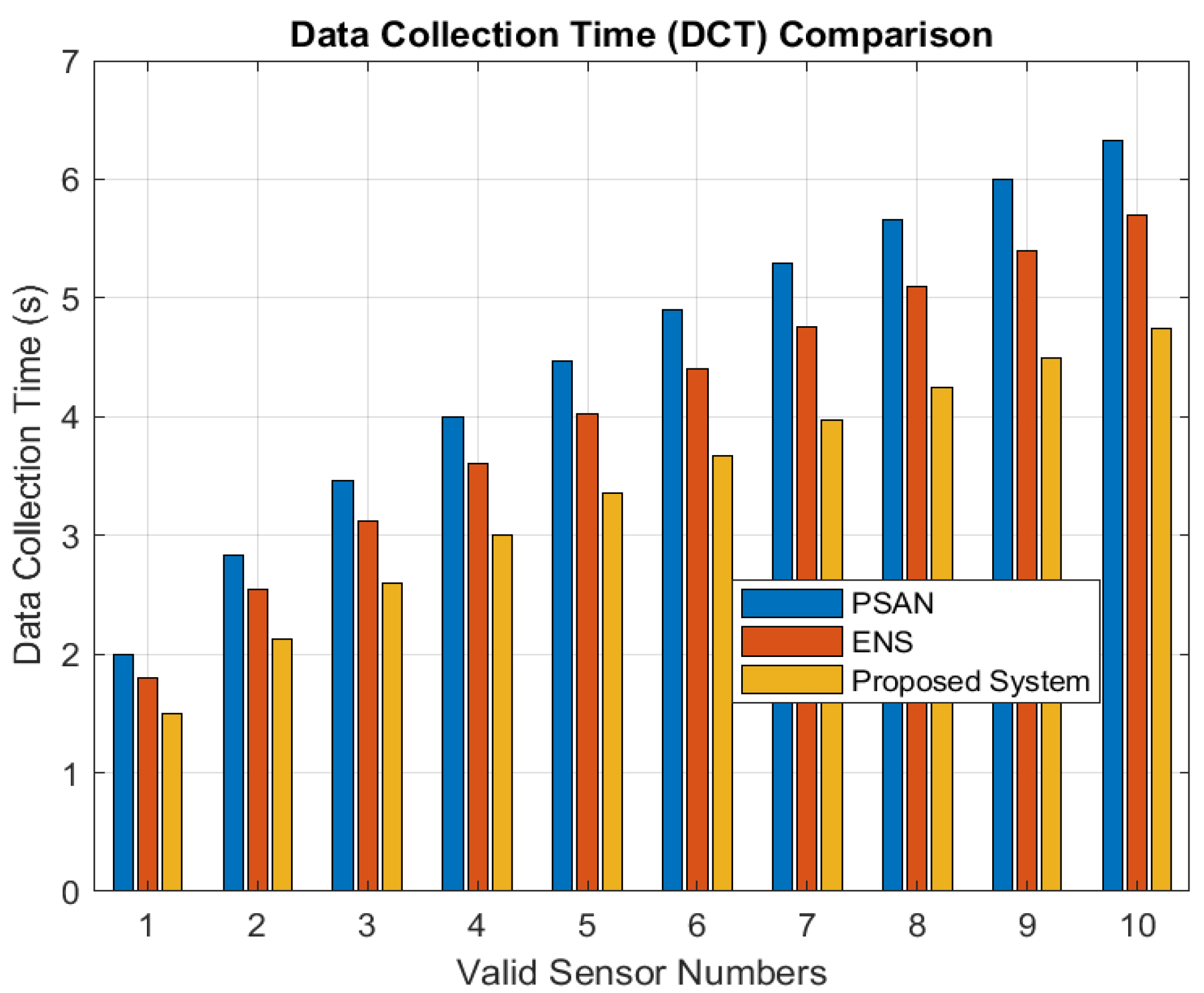
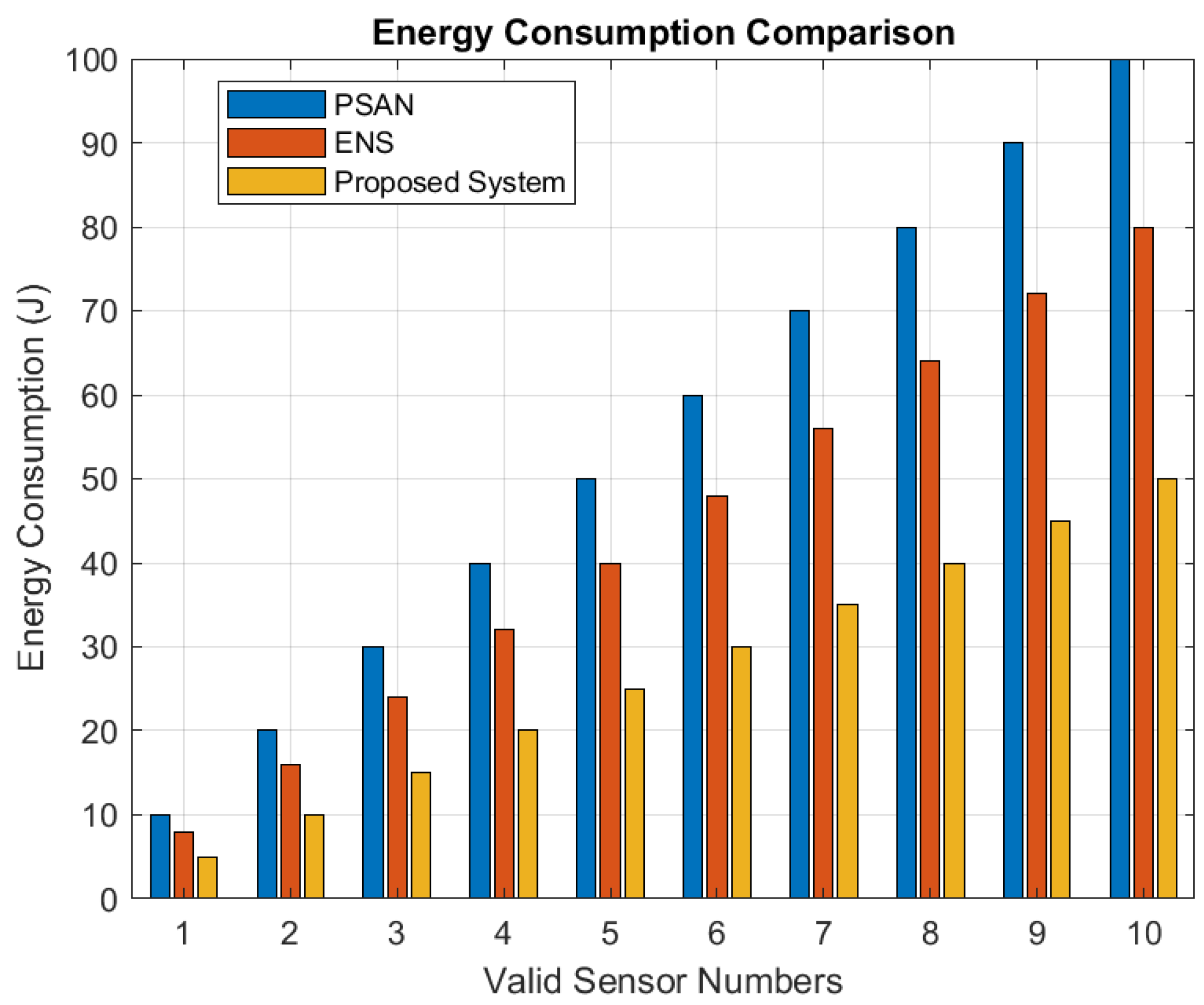
| Parameters | Value |
|---|---|
| Number of sensor nodes (n) | 100 |
| The energy of node Eo | 0.5 J |
| CH selection probability (p) | 0.1 |
| Transmitter’s energy ETx | 50 × 10−10 J |
| Receiver’s energy ERx | 50 × 10−10 J |
| Energy (free space) Efs | 10 × 10−11 J |
| Energy (Multipath fading) Emp | 0.0013 × 10−12 J |
| Energy (Data aggregation) EDA | 5 × 10−9 J |
| Maximum rounds Rmax | 5000 |
| Distance Threshold (free space) d0 | 87 m |
| Data Rate | 250 Kbps |
| Minimum Residual Energy (Eth) | 10 J |
| Frequency | 25 kHz |
| Sensing Range of Each Meter (sensing range) | 20 m |
| Latency Rates | 0–50 Mbps |
| Simulation Time (t) | 10 s |
Disclaimer/Publisher’s Note: The statements, opinions and data contained in all publications are solely those of the individual author(s) and contributor(s) and not of MDPI and/or the editor(s). MDPI and/or the editor(s) disclaim responsibility for any injury to people or property resulting from any ideas, methods, instructions or products referred to in the content. |
© 2024 by the authors. Licensee MDPI, Basel, Switzerland. This article is an open access article distributed under the terms and conditions of the Creative Commons Attribution (CC BY) license (https://creativecommons.org/licenses/by/4.0/).
Share and Cite
Hoque, M.J.; Islam, M.S.; Ahmed, I.; Nurullah, M. Enhancing Precision Agriculture Efficiency Through Edge Computing-Enabled Wireless Sensor Networks: A Data Aggregation Perspective. Eng. Proc. 2024, 82, 90. https://doi.org/10.3390/ecsa-11-20412
Hoque MJ, Islam MS, Ahmed I, Nurullah M. Enhancing Precision Agriculture Efficiency Through Edge Computing-Enabled Wireless Sensor Networks: A Data Aggregation Perspective. Engineering Proceedings. 2024; 82(1):90. https://doi.org/10.3390/ecsa-11-20412
Chicago/Turabian StyleHoque, MD Jiabul, Md. Saiful Islam, Istiaque Ahmed, and Md. Nurullah. 2024. "Enhancing Precision Agriculture Efficiency Through Edge Computing-Enabled Wireless Sensor Networks: A Data Aggregation Perspective" Engineering Proceedings 82, no. 1: 90. https://doi.org/10.3390/ecsa-11-20412
APA StyleHoque, M. J., Islam, M. S., Ahmed, I., & Nurullah, M. (2024). Enhancing Precision Agriculture Efficiency Through Edge Computing-Enabled Wireless Sensor Networks: A Data Aggregation Perspective. Engineering Proceedings, 82(1), 90. https://doi.org/10.3390/ecsa-11-20412








